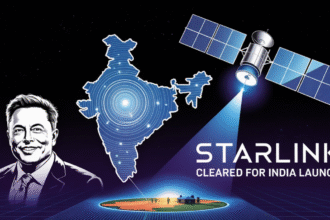In a major development for India’s digital infrastructure, Elon Musk’s Starlink has received approval to launch satellite-based internet services in the country. The Indian government has granted the company a Global Mobile Personal Communication by Satellite (GMPCS) license, marking a crucial step in Starlink’s entry into one of the world’s largest and fastest-growing internet markets.
This regulatory nod follows months of back-and-forth between Starlink and Indian authorities, centered largely on national security compliance and data sovereignty concerns.
Regulatory Green Light
The Department of Telecommunications (DoT) issued a Letter of Intent (LoI) to Starlink on May 7, 2025, initiating the licensing process. After successfully fulfilling the conditions outlined in the LoI, Starlink has now been officially awarded the GMPCS license, clearing the way for the company to roll out services across the country.
National Security Compliance
One of the biggest hurdles for Starlink had been meeting India’s strict data and security regulations. As part of its licensing conditions, Starlink will establish a command-and-control center within India to manage operations and ensure compliance with domestic interception and monitoring protocols. These measures were introduced to ensure that satellite-based services don’t compromise national interests.
Starlink has reportedly agreed to all such provisions, reflecting its growing willingness to localize operations to enter high-potential markets like India.
What Comes Next?
Starlink officials are expected to visit New Delhi in the coming days to finalize paperwork and begin operational planning. With the license in hand, Starlink can now initiate beta services, followed by broader deployment across rural, remote, and underserved parts of India — areas where traditional broadband providers face infrastructure challenges.
The company is also expected to work with Indian telecom partners and local ISPs to accelerate rollout and ensure alignment with broader Digital India objectives.
Why It Matters
Starlink’s entry into India is more than just another telecom announcement — it represents a significant leap in bridging India’s digital divide. For millions living in far-flung villages, deserts, and mountainous terrain, high-speed internet has remained out of reach. With Starlink’s low-orbit satellite constellation, broadband coverage could become a reality in these pockets, helping boost education, e-commerce, telemedicine, and governance.
Moreover, its entry could disrupt the existing broadband market, spurring traditional telcos and ISPs to expand and improve their services in a bid to stay competitive.

